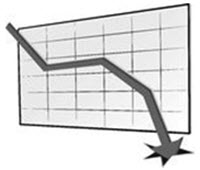It’s the last week of the quarter and everything is looking good. You have the deals in the tank to hit the target. Then it happens: Things start slipping and it’s not pretty. Deals are falling faster than ice cream melting on a summer day. You panic and start slashing prices to get deals closed, but it’s no use. You missed the number!

You ask yourself what happened. You now have to spend your weekend doing a post mortem. You have a call with your sales managers to get their input. You’re hearing things like:
- “Deals were pushed due to people being on vacation”
- “The customer decided to wait”
- “The competition came in at the last minute and beat us on price”
- “We didn’t have good visibility to deals in our CRM”
The last point makes you stop and think. “Is our CRM causing us to miss our number?” Rarely do leaders look at their CRM usage as being part of the problem. They spend time implementing it and then it’s off to the races. Successful sales leaders learn how this management tool will help them hit their quota. They embrace the technology and cascade the usage down through their sales organization. In this article, we are going to review some keys to CRM success.
Know the Sequence
I was with a client this week that is purchasing a CRM solution. During a conversation I was asked when to implement the system. Should it be done before or after we update their sales process? It’s a question that many sales leaders face on a regular basis. The correct sequence is to develop or improve your sales process first. You don’t want to automate a bad process in your CRM. If you have a bad process, you will continue to miss the number. Here are a few tips:
- Lead management- You need to understand how the CRM will be used. Leads will need to be captured coming into the sales funnel. This is a critical step in marketing and sales integration. This is also where you need to evaluate integration with a marketing automation tool.
- Opportunity management– Once a lead moves to an opportunity, you need to manage it differently. Teach your sales team on what a lead is and how to qualify one. This will shorten the sales cycle. You should also ensure you map your process to your buyer.
- Forecast cadence– Make sure that you have clear definitions of pipeline vs. the forecast. They are two distinct stages in the sales process. I would work with your management team to create a forecast review process. Focus on the following:
Changing Behavior
Once you roll out the system, you need to focus on behavior changes. This is a very important step that many times gets overlooked. Your adoption plan should focus on how your CRM forecast will be used. Make sure you train and reinforce the actions and steps needed for transparency. If your sales team does not use the system, you wasted time and money. Start identifying quick wins as reps and managers embrace the system. Here some key topics to focus on when getting CRM adoption:
- Don’t let sales reps hide deals outside the CRM system- You and your managers should not tolerate this practice. I’ve seen organizations not pay commissions on deals that were hidden prior to closing.
- Make sure your team is following the sales process- Don’t allow steps to be missed. When shortcuts are taken in the process, deals will slip. This is just as important when using the CRM. Teach and reinforce how opportunities should be moved through the sales cycle. Run a contest to get that change of behavior for CRM adoption.
- Get your hands dirty- Don’t become disconnected from big deals. Get personally involved in some large opportunities and use the CRM to review them. This will give you the ability to see gaps. Then work with your team to close any holes you notice during your reviews. Finally, update your CRM accordingly. This could include reporting, stage progression, visibility, or administrative tasks that impact productivity.
Learn From Failure
As part of your post mortem, review 2-3 slipped deals. Go back and follow them from lead through the opportunity stages. Identify where things went wrong and review what could have been changed. This exercise will help you capture areas that need to be fixed. It will also help educate your team. How you recover and fix any issues will be a test of your leadership. Don’t get complacent. Don’t blame your CRM either. You need to be an agile leader. Learn from your mistakes and teach your team how to get better. See how we helped a client turn things around. Take a look at the CRM Success Case Study.




